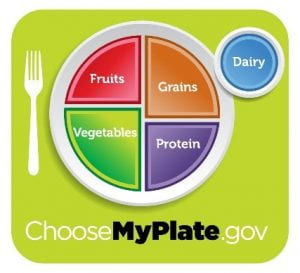A new personalized, downloadable app makes meal and exercise planning easier
new personalized, downloadable app makes meal and exercise planning easier
MyPlate—what is it? Your kids may come home from school (in-person or online) talking about MyPlate. School cafeterias have bright MyPlate posters and stickers on the walls and tray line, showing the food groups that make up a healthy eating plan. But if you don’t have kids in the house right now, you may not know what MyPlate is.
You may remember the USDA Food Pyramid. It was complicated, and had a lot of “don’ts.” MyPlate, which replaces the Pyramid, highlights the positives. It’s an easy and helpful mental framework for planning, buying, and preparing healthy meals, whether you’re a single person or have a houseful.
There are five food groups: Vegetables, Fruits, Grains, Proteins, and Dairy. Each of the groups has a tagline or saying, to help you remember what’s important. Note that vegetables and fruit make up half the plate: that’s probably biggest difference between the plate and the old pyramid. It also motivates us to think about having the bulk of our meals be plant-based, rather than relying on traditional meat-and-potatoes dinners many of us older folks grew up with. 
The Choose MyPlate web site has videos, tip sheets, and ideas to make healthy and low cost meal planning and exercise easier, including a MyPlate Personal Eating Plan app based on your age, gender, and physical activity level. There’s also a new MyPlate Kitchen web site, with tons of low cost, simple recipes (this replaces the old USDA Mixing Bowl web site). There are enough ideas and inspirations to kick-start a new you for the rest of the year. So check out the resources below!
- My Plate Personal Eating Plan: downloadable app
- Start Simple with MyPlate video
- MyPlate Kitchen web site: recipes galore. Cheap, tasty, easy.
- My Plate Kids’ Place: games, coloring sheets, kid-friendly recipes, more!
Recipe Of the Week:
It’s hot out! Don’t know about you, but I don’t feel like fussin’ in this weather. Here’s a no-cook recipe to keep it simple:
Tuna Boats
Serves 4, 1/2 cucumber and 6 ounces filling per serving
Ingredients:
- 2 large cucumbers
- 1 lemon
- 2 green onions
- 1 (6-ounce) can low-sodium tuna, packed in water
- 1 (15 ½-ounce) can white beans
- 1 Tablespoon canola oil
- 1 Tablespoon Dijon or country mustard
- ¼ teaspoon salt
- ¼ teaspoon ground black pepper
Instructions:
- Rinse cucumbers. Peel off skin every ¼ inch, all the way around. Cut lengthwise. Scoop out the seeds with a small spoon.
Rinse lemon. Zest using the small holes of a box grater. Cut in half. In a small bowl, squeeze juice. Discard seeds.
3. Rinse and chop green onions.
4. Drain tuna. In a colander, drain and rinse beans.
5. In a medium bowl, mash beans lightly with a fork.
6. Add green onions, tuna, oil, mustard, salt, pepper, lemon zest, and 2 Tablespoons of the lemon juice to beans. Mix with a fork.
7. Fill each cucumber half with ¼ tuna mixture. Serve.
Chef’s Notes:
- For a snack or party food, cut cucumbers into thick slices. Do not remove seeds. Place a dollop of tuna mixture on top.
- Add chopped bell pepper or celery for extra nutrition and crunch.
- Try canned salmon, packed in water, instead of tuna.
Photo credits: https://www.choosemyplate.gov/; https://cookingmatters.org/
Recipe credits: https://cookingmatters.org/
Post brought to you by:
Joan Martin
SNAP-Ed Nutritionist, CCE Schuyler



